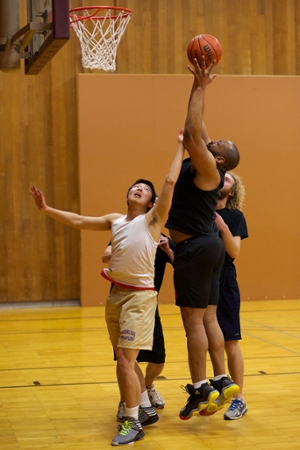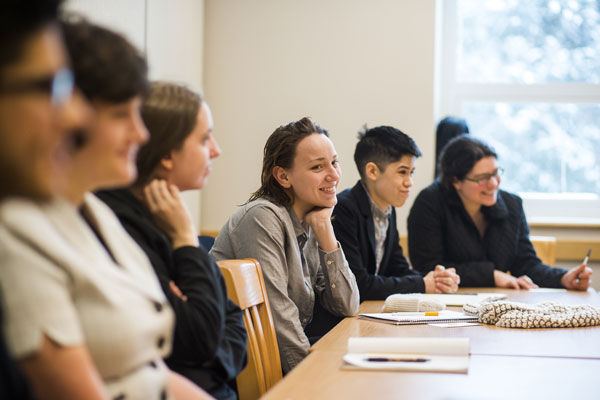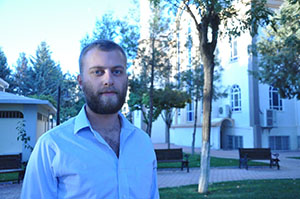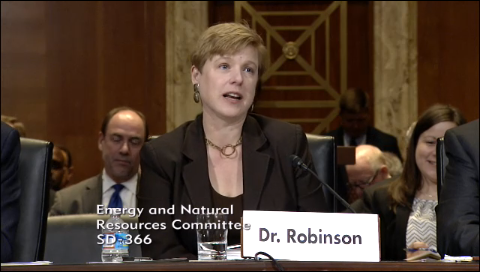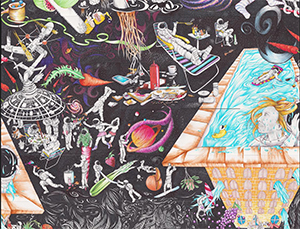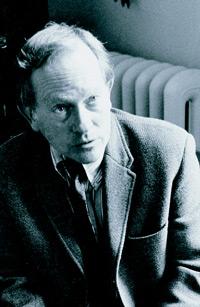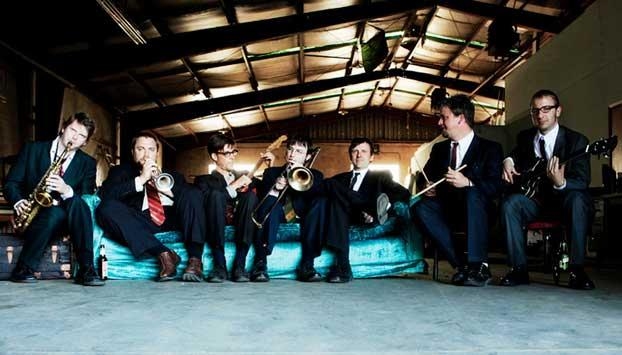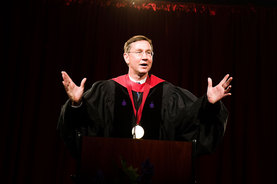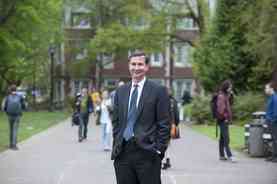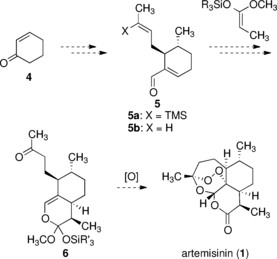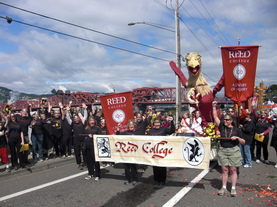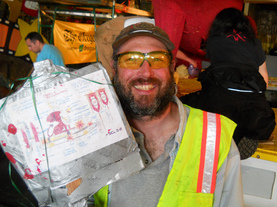
IRIS login | Reed College home Volume 96, No. 2: June 2017
Tags
"alumni"
Marketplace Spices Up Reunions 2014: Reedfayre
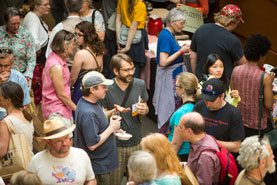
Hungry alumni swarm Marketplace at Reunions to taste creations of the culinary, mixological, and intellectual variety. Leah Nash
On Saturday afternoon of Reedfayre, the Performing Arts Building was abuzz with alumni, students, and families browsing the crafts, comics, cosmetics, and, most numerous of all, culinary creations, all cooked up by Reed alumni.
Always ready for a grand appearance, the Meat Smoke Crew greeted guests with enough pulled pork and brisket sandwiches to choke a Doyle Owl. Gigantic Brewing offered samples of its latest seasonal beers, including the Firebird smoked Hefeweizen, which founder Van Havig ’92 described as “like a peanut butter cup . . . two great things making one amazing thing.” Next door, Daniel Thomas ’89 served up delicious red and green tamales from his popular Portland restaurant Xico.
One of the most arresting displays belonged to Bob Combs ’90 of Combs Honey, whose table featured a transparent container filled with honeycomb—and live bees. Once drawn in by the bees, I couldn’t help but sample his blackberry honey and take home a couple slabs of honeycomb for myself.
Continue reading Marketplace Spices Up Reunions 2014: Reedfayre
Alumni Trounce Students in Ultimate Showdown
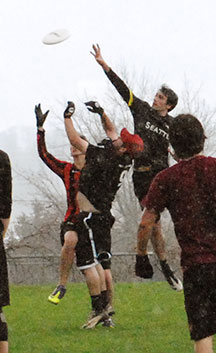
Bryson Uhrig-Fox ’10 knocks down the competition as he snatches the disc from students' awaiting grasp. Photos by Kimberly Durkin ’13
Experience and cunning overwhelmed youth and bravado two weeks ago as a team of alumni all-stars dominated Reed students 17-8 in an epic alumni-student Ultimate Frisbee game.
The upper soccer field outside the Naito-Sullivan dorms was spattered with a decade's worth of uniforms as lanky students in red huddled in one end zone to gather courage against the talent-laden alumni in black. Student team captains Sam May ’13, Daniel Dashevsky ’13, and Xander Harris ’16 rallied their players with jokes about alumni beer bellies. Alumni heavy hitters Bryson Uhrig-Fox ’10, Andrew Lynch ’12, and Shane Rubenfeld ’06 (who coaches the student team when he’s not playing against them) traded quips about the sleep-deprived students.
Continue reading Alumni Trounce Students in Ultimate Showdown
Young Alumni Triumph in “March Madness” Tourney
Alumni dominated Reed’s annual March Madness basketball tournament last week as Just Blasé (composed of younger alumni) edged out the Has-Beens (older students) 30-26 in a hard-fought final match.
Now in its 26th year, the madcap single-elimination tournament features eight teams, composed of students, alumni, professors, and staff. Some players show considerable skill, others haven’t touched a ball in years. It’s not uncommon to see teams fielded by dorms, academic departments, the Ultimate Frisbee team, or the rugby team. The combination of wildly different levels of talent makes for exciting games, which progress from fun and sloppy to tense and skilled as the tournament moves into its final rounds.
There are some unique rules, too, that add elements of unpredictability to March Madness, including a running game clock, meaning that play is never stopped during the 12-minute halves, and the three-foul-limit per player, which requires any player who commits three fouls to leave the game immediately. This can cause teams to have to play with less than five players, if too many of their players foul out.
Continue reading Young Alumni Triumph in “March Madness” Tourney
Combating Sexism in STEM
As snow fell outside, Reedies braved the cold to take part in “Women in STEM,” a panel discussion for students in science, technology, engineering and mathematics, on Saturday.
The session was part of Reed’s 2014 Working Weekend, an event hosted by the Center for Life Beyond Reed to help students learn about career paths and strategies from Reed alumni.
Attendees might have anticipated that a major theme in the discussion would be the difficulties of being female in the male-dominated STEM world, but Janet Gunzner-Toste ’93 set the tone by saying, “I didn’t know there were gender issues in science. I just plowed ahead and enjoyed it.”
Continue reading Combating Sexism in STEM
Performing Arts Building Takes Center Stage
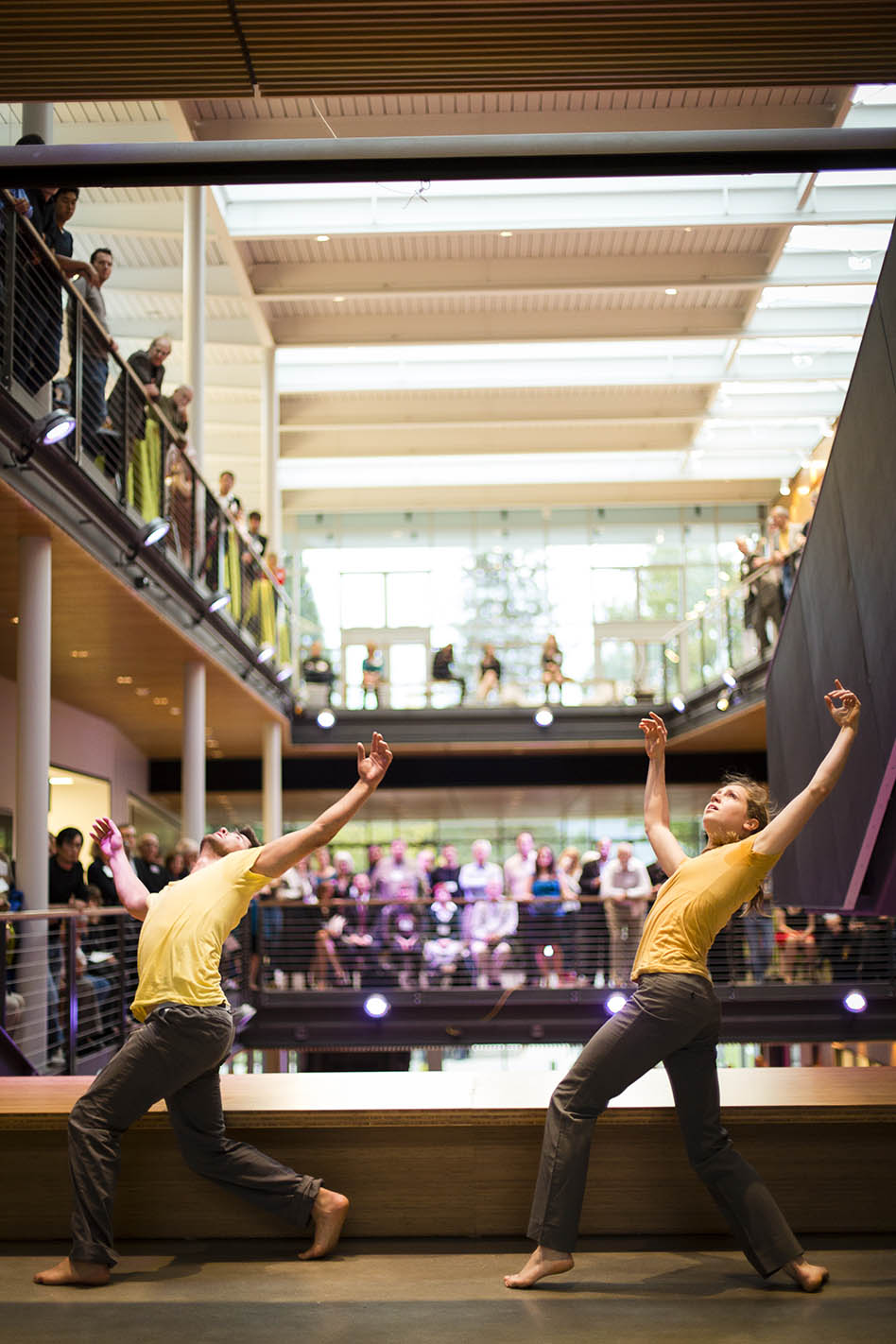
Dancers perform "L'esprit de l'escalier," choreographed by Heidi Duckler ’74, to ring in the new Performing Arts Building. Photo by NashCo
Reed’s performing arts just got an 80,000 square-foot, glass-paned, light-filled, no-holds-barred, swanky new home. Years in the making, the Performing Arts Building is finally ready to take center stage. Classes are already being held in the building and its myriad rooms and performance spaces are beginning to hum.
The building opened Friday, September 20, amid pomp and circumstance, shiny red ribbons, and several gargantuan pairs of scissors.
The ceremony began with Blast!, a fanfayre for trumpet and synthesizer, composed by Prof. David Schiff [music 1980–]. Then, standing on the grand staircase that graces the atrium, President John Kroger welcomed students, faculty, staff, alumni, and guests, giving thanks to the many people who ushered the building into reality.
Continue reading Performing Arts Building Takes Center Stage
Rescuing Survivors from Syria's Rubble
When surgeon Muhammad Abyad was killed in Syria on September 5, as he did humanitarian work for Doctors Without Borders, it was hardly an isolated incident. Hospitals are routinely bombed in the chaos of current-day Syria, and so far over 20 staffers for the Syrian Arab Red Crescent have perished while responding to disasters. On Monday, 50 medical professionals from across the globe united to publish an open letter in the Lancet saying that the Syrian health system is at a breaking point.
Somewhere in southern Turkey, Eliot Stempf ’11 knowingly nodded his head—and shifted in his low-rent desk chair as he contended with a glacially slow internet connection. Eliot lives in Gaziantep, Turkey, roughly 20 miles from the Syrian border, and is currently masterminding the launch of a humanitarian startup, SERA (Special Emergency Response and Assistance), which specializes in prehospital care and has so far trained roughly 50 Syrians to become emergency first responders.
SERA was founded in late 2012 by Peter Kassig, a 24-year-old Army Ranger and Indiana native who returned from Iraq intent on mitigating the carnage of war. Kassig, who’s an EMT, lives with Eliot in Gaziantep and frequently forays into war-torn Syrian towns like Deir Ezzor to lead training sessions, distribute supplies, and provide basic medical care. Eliot, meanwhile, remains in Turkey, hunched at his computer, networking with care providers, such as the Red Crescent, and conferring with two Syrian doctors who advise SERA on, as Eliot puts it, “how to deliver aid in a way that’s sensitive, without exacerbating political tensions.”
Continue reading Rescuing Survivors from Syria's Rubble
Dispute over Reed’s location brightens Senate hearing
Stalwart correspondent Ed Mills ’80 drew our attention to a lighthearted exchange that took place this week during a hearing before the U.S. Senate Committee on Energy and Natural Resources, chaired by Senator Ron Wyden [D-Oregon]. The committee was meeting to consider several of President Obama’s nominations—including Dr. Beth Robinson ’82 to the post of Under Secretary of Energy.
Committee hearings not exactly famous for their levity. When they aren’t immobilized by partisan wrangling they tend to be--how shall we put it?--less than riveting. Approximately two and a half hours into the hearing, however, the session was enlivened by a surprising geographic issue:
Dr. Robinson to Senator Cantwell [D-Washington]: "Yes, the issues at Hanford are very complex and very important, and as you mentioned, I grew up in Seattle, which is--"
Continue reading Dispute over Reed’s location brightens Senate hearing
"Star" Graces Performing Arts Building
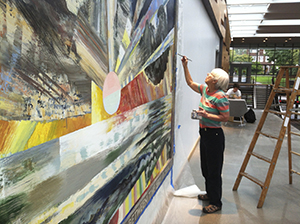
Artist Lucinda Parker ’66 adds the finishing touches to the installation of "Our Solo Round Star Squeezed Between the Sky and Sea" in Reed's Performing Arts Building. Chris Lydgate ’90
Reed has received a grant of $28,000 to acquire the painting Our Solo Round Star Squeezed Between the Sky & Sea by celebrated Portland artist and Reed College alumna Lucinda Parker ’66. This acquisition was made possible with the assistance of the Ford Family Foundation through a special grant program managed by the Oregon Arts Commission (OAC). “The college is thrilled to acquire such a substantial work of art by a distinguished alumna during an era of profound growth and innovation in the arts at Reed," says Cooley Gallery director Stephanie Snyder ’91. "Lucinda Parker is a visionary painter, and an integral part of the Reed community. Her work chronicles the living history and vitality of the Northwest with unmatched vibrancy.”
Our Solo Round Star Squeezed Between the Sky & Sea, completed this year, is a monumental acrylic on canvas painting, measuring 91 x 153 inches. Its particular subject matter and the circumstances of its creation are unique within the artist’s oeuvre. Parker created the work while an inaugural artist-in-residence at the Robert Rauschenberg Foundation Residency Program at the late artist’s Florida studio complex. During the residency, Parker spent an entire month observing and making small gouache studies of the sunset. Concurrently, she began working on this encompassing vision of natural rhythm and spiritual transformation. In her words: “The painting explores death and renewal—the mystery of where the sun goes when it disappears into the ocean—old myths.”
Lucinda Parker is one of the Pacific Northwest’s most significant and enduring painters. She is associate professor in painting and drawing, emerita, at the Pacific Northwest College of Art, where she studied fine arts in a dual-degree program with Reed, and an MFA graduate of the Pratt Institute. Her work has been shown at numerous institutions, including the Portland Art Museum, the Jordan Schnitzer Museum of Art, the Seattle Art Museum, and Marylhurst University. Her work is represented by the Laura Russo Gallery in Portland.
Continue reading "Star" Graces Performing Arts Building
Sketching Infinity
The universe of Vance Feldman ’05 explodes with jumbled houses, bridges and aqueducts, businessmen shaking hands, dolphins jumping out of rivers, and spacemen kicking their feet back in lawn chairs. To call his work monumental would be something of an understatement. Modestly titled the ForeverScape, his drawing rivals some of the longest art pieces in the world. Spanning roughly 650 feet from left to right—the equivalent of two football fields—the ForeverScape is assembled out of 700 sheets of letter-size paper and grows longer by the day.
The ForeverScape started in September, 2009, when Vance was in between jobs and found himself sitting in a bar with a ream of paper. He started aimlessly sketching a landscape and when the first page ended saw no reason to stop. The first couple hundred pages, drawn in ballpoint pen, feature a smoggy, industrial landscape littered with crowded buildings twisting into each other and spilling onto the road and barbed wire fences about to snag innocent hummingbirds. These give way to apocalyptic scenes of civilization being swallowed by the sea. Squid and clownfish lazily swim above a submerged city whose buildings are wreathed in slimy weeds and whose skyscrapers are tickling the belly of a whale. One scene depicts several men attempting to subdue and photograph what appears to be the Loch Ness monster. Later, after Vance switched to using a Sharpie, the sea becomes the sky and we zoom into a psychedelic rendition of outer space, filled with boats and clams and astronauts playing badminton in reclining lawn chairs.
The chairs pay homage to Prof. Michael Knutson [art 1982–], who once told Vance that all he painted for several years were lawn chairs. Prof. Knutson likes the piece so much that he shows it to his art classes every year. The ForeverScape demonstrates, he says, “an incredible imagination, focus and energy.” In a subtler way, it also evokes a childhood loss and a lesson Vance learned at Reed.
Continue reading Sketching Infinity
Reedies Nab NSF Fellowships
Margit Bowler ’11, Quinn Langdon ’11, and Christina Porter ’13 all won fellowships from the National Science Foundation this year as part of the NSF’s prestigious Graduate Research Fellowships Program.
The program grants each fellow $32,000 a year for three years to pursue a specific research proposal, plus $12,000 a year to the individual's institution. Students may apply to the program their senior year or during their first two years of graduate school.
Margit Bowler ’11 will do fieldwork in the language of Warlpiri, spoken solely by approximately 3,000 indigenous people in central Australia. Her project represents a continuation of the research she began thanks to a Fulbright Scholarship she won in 2011; she is thankful to NSF for the opportunity to continue her research, as she believes Warlpiri should not be studied without a longterm commitment to its speakers and their communities. She is currently at UCLA researching Warlpiri semantics and syntax although she occasionally delves into Warlpiri phonology.
Continue reading Reedies Nab NSF Fellowships
The Dudman Files
Prof. Jack Dudman ’42 played many roles at Reed—often simultaneously. Student leader, proud graduate, inspiring teacher, patient mentor. But he is probably best remembered as dean of students, an office he held from 1963 to 1983—during which time he helped hundreds of students through some of the most difficult times of their lives.
John Almon Dudman was born in Iowa in 1920 and majored in mathematics at Reed, where he made a deep impression on Prof. Robert Rosenbaum [math 1939–53]. “Jack was the best of the group,” Rosenbaum wrote later. “Not just in seriousness and diligence, although he clearly held his own in these qualities—but in the imagination that he brought to his study, and in the evident pleasure that he took from beginning to see the roles that mathematics plays in human culture.”
Dudman was elected student body president and became an active student advocate. During that time, two male students were involved in a homosexual relationship which somehow became public; college administrators were determined to put an end to it. Dudman argued that the students’ relationship was a private matter and that the college had no business meddling in their affairs. Sadly, his arguments fell on deaf ears and the students were expelled.
Continue reading The Dudman Files
Reed's Oral History Project Wins Honors
Reedies have known for some time that Comrades of the Quest is a signal achievement. Since its publication last summer, the magisterial oral history of Reed, edited by John Sheehy ’82, has been devoured by Reedies on campus and elsewhere (check out these tidbits that were excerpted in Reed magazine). The book quickly became an invaluable tool for alumni to understand their school and their role in its history. Lately, however, Comrades and the Oral History Project—which produced the enormous treasure trove of interviews which are the basis for the book—have received recognition in the wider world as extraordinary works of scholarship.
The Oral History Association has just named the Reed College Oral History Project as the recipient of its prestigious Elizabeth Mason Large Project Award, given for outstanding works of oral history. The awards committee found that the project had been completed at “consistently high standards of professionalism, ethics, and scholarly rigor,” and that it made “important contributions to the social and cultural history of education.”
Continue reading Reed's Oral History Project Wins Honors
Reed Switchboard Selected from 400 Applicants for $20K Slice of PIE
Reed Switchboard, the networking site created to share Reed love, has been given a boost by Wieden & Kennedy as part of the ad firm’s Portland Incubator Experiment (PIE). Switchboard is the networking brainchild of Mara Zepeda ’02 and Sean Lerner ’10. They created the website so current Reedies and alumni could share their work experiences, offer assistance, post jobs, and give community members a leg up in a post-recession and increasingly competitive job market.
PIE had an ultra-competitive selection process, with only seven tech start-ups picked out of over 400 applicants. Switchboard, a Reedie endeavor, manned by Reedies, and beta tested on Reedies, was one of the lucky seven. Each startup receives $20,000 in seed money, office space at Wieden & Kennedy, and three months of hands on mentorship from past PIE winners and other successful technological ventures.
Mara and Sean are hoping to use the money and expertise they gain through PIE to open up Switchboard to other college communities, offering the same basic format that connects Reedies with Reedies, but instead connecting Clarkies with Clarkies, and so on.
Continue reading Reed Switchboard Selected from 400 Applicants for $20K Slice of PIE
Savoring the Taste of Reed
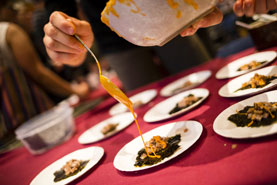
Minced pig trotters served on seaweed with a pepper aioli, offered a provocative mix of sweet and spicy. Photo by Leah Nash
Fresh bread, sweet honey, and a crisp wine to wash to all down. It’s not heaven, but it may be the next best thing: Gastronomy Northwest, the annual festival of food and drink produced by and for alumni, was held on Saturday afternoon of Reunions ’13: Reedfayre.
Making a piquant comeback from last year were David Autrey ’89 and his partner Amy Wesselman ’91 of the Westrey Wine Company, who served a delicate 2012 pinot gris and a refreshing 2010 pinot noir (you may have heard of their rising-star sons?). Also returning was the Clear Creek Distillery, operated by master distiller Steve McCarthy ’66 and his wife, artist Lucinda Parker McCarthy ’66. The Portland distillery employs mostly Reedies and specializes in brandies and liqueurs created from the fruit grown in the family’s orchards at the foot of Mount Hood. Their summery loganberry liqueur accented the natural tartness of the berry while perfectly satisfying the sweet tooth.
Continue reading Savoring the Taste of Reed
Getting Funky at Reunions
Saturday night at Reunions '13: Reedfayre, June 12-16, doesn’t begin with the fireworks. This year, it starts with Tezeta Band, Portland’s premier Ethiopian-style rock band. Tezeta Band is a sort of reunion in itself: the band is composed of members of the Five Fingers of Funk, the hip-hop funk fusion band that rocked Portland in the 1990s.
Formed in 1992, with a career that spanned nearly 10 years, Five Fingers was the Pacific Northwest’s premier hip-hop experience, opening for the likes of De La Soul, The Roots, and Run DMC. Five Fingers wound down in the early oughts, with frontman-rapper Pete Miser leaving Portland for Brooklyn. The rest of the band stayed in the Rose City, however, and, after a few years pursuing their own projects, came back together in 2006 to explore new sonic territory: Ethiopia. For the last seven years the band has jammed on the unique fusion of jazz, rock, soul, and traditional African that defined Ethiopian music during its golden era of the 1960s and ’70s (captured in the wonderful album series Éthiopiques). Tezeta will be bringing all their influences on Saturday evening, so whether you’re a hip-hop head or a funk connoisseur, come on down to the SU and be prepared to boogie.
Continue reading Getting Funky at Reunions
March Madness at Reed—Yes, Reed

High fashion and devious fakery abound at Reed's March Madness (Photo from 2005). Photo by Orin Bassoff
Reedies packed the sports center on March 15 for an event they had been waiting for all spring. This wasn’t part of RAW, Reed’s annual arts week; it was a very different type of exhibition—March Madness.
Although March Madness at Reed may not feature as many teams—or as much advertising—as the NCAA version, its passion and intensity are unrivaled. This year marked the event’s 25th anniversary, and it showed in the approximately 200 spectators, participants, and supporters alike, who came out to watch the fun.
March Madness is a one-night, single-elimination tournament, featuring eight teams, compiled of Reed students, alumni, professors, and staff. The contest has its origins in 1989 when the Reed student team, which included Erik Brakstad ’89, was clobbered by a team made up of professors. “I thought to myself, where else would the student team lose to the faculty?” Erik said. He founded the tournament as a chance to get even for the loss, and the mania has only mounted since then.
Continue reading March Madness at Reed—Yes, Reed
Kroger Inaugurated—with <i>Iliad</i>
Amid the call of bagpipes and the flourish of horns, roughly 1,500 people descended on campus on Friday to welcome John R. Kroger as Reed's 15th president. Under the big top on the great lawn, Roger Perlmutter '73, chair of the board of trustees, invested Kroger with the trappings of office—including a copy of the Iliad and a bottle of spring water drawn from the Reed Canyon—in a grand inauguration ceremony.
Student body president Brian Moore '13 hailed Kroger as "the ultimate prospie" for his infectious enthusiasm for all things Reed and for enrolling in Hum 110.
Continue reading Kroger Inaugurated—with <i>Iliad</i>
The Dipylon Analogy
Dear Reed Alumni:
The academic year is underway! The campus looks beautiful, the Paradox Café is packed, and the mood on campus seems excellent. My enthusiasm for Reed, and my conviction that the college is in great shape, have only grown deeper in the last two months. I look forward to my formal inauguration on September 21 and the accompanying Alumni Leadership Summit. I hope to meet many of you at these celebratory and informative events.
Continue reading The Dipylon Analogy
Fighting Malaria On the Cheap
Malaria is a killer. Over 200 million people are infected every year, and over one million, mostly children, die as a result. It is not a lack of medicine that allows malaria to run rampant; a highly effective treatment called Artemisinin-based Combination Therapy (ACT) has existed for years. The issue is cost: ACT's main ingredient, artemisinin, is prohibitively expensive. A research team led by Indiana State University professor Silas Cook '99 has found a way to change that.
Artemisinin is usually obtained in one of two ways: harvesting it from its natural home in the sweet wormwood plant, or using a bit of biological alchemy to create a synthetic version. Harvesting it from wormwood is a difficult process to begin with: combined with crop shortages caused by poor planning, natural disasters, and other unpredictable disruptions, this method has proven incapable of providing a consistent, cheap yield.
Continue reading Fighting Malaria On the Cheap
Reed Griffin is Rose Parade Royalty
Six-inches high and stuffed with cotton, a griffin sits atop a few worn books stacked on the cluttered desk of Mike Teskey, director of alumni & parent relations. For years this figurine—a plush model of the mythical creature, half lion, half eagle, which Reed takes as its mascot—had fixed its glassy eye on Mike while he worked, and it must have made an impression, because when he walked into the office of the Portland Rose Festival representative to discuss what Reed's float would look like in the upcoming parade, Mike had the stuffed griffin in his hand.
The last time Reed entered a float in the Grand Floral Parade was in 1936. From time to time, alumni would broach the dream of returning to the parade, but like a lot of great ideas, they never got past the broaching stage. Then, at a centennial apple-pressing party in the canyon orchard, Mike struck up a conversation with Jon-Paul Davis '93 and mechanical wizard Rob Mack '93. Rob was the natural choice to spearhead the project; during his Reed days he turned an old Nissan into the infamous Mobile Outdoor Plush Super Upholstered Den (MOSPUD), a mobile beverage-distribution system that graced several Renn Fayres. Rob signed on as Reed's construction leader for the 2012 parade with just one demand: Reed would build the float.
Continue reading Reed Griffin is Rose Parade Royalty

